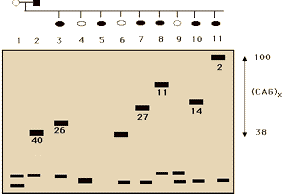Recombinant DNA Technology Problem Set
Problem 4 Huntington's disease
Correct!
The data below shows the results of electrophoresis of PCR fragments amplified using probes for the site which has been shown to be altered in Huntington's disease. The male parent, as shown by the black box, got Huntington's disease when he was 40 years old. His children include 6 (3,5,7,8,10,11) with Huntington's disease, and the age at which the symptoms first began is shown by the number above the band from the PCR fragment.

A. No relationship between age of onset of disease and the migration rate of PCR fragments. B. A shorter PCR fragment predicts early onset of Huntington's disease. C. Increased length of the amplified PCR fragment predicts early onset of Huntington's disease. There is an inverse relationship between the number of CAG repeats and the age at which Huntington's disease begins.D. Huntington's disease must be contagious since many of the children have the disease. E. None of the above.
University of Arizona
Tuesday, October 29, 1996
Contact the Development Team
http://biology.arizona.edu
All contents copyright © 1996. All rights reserved.






